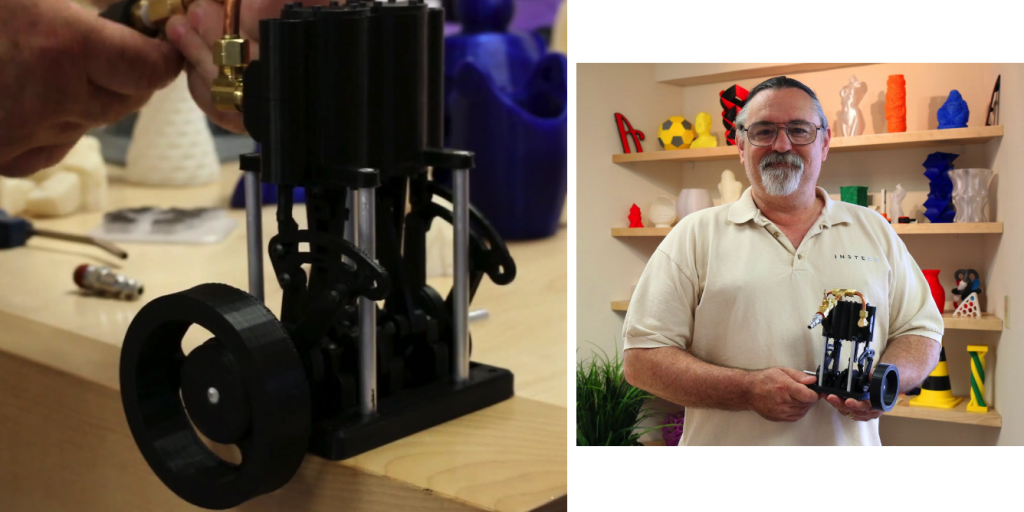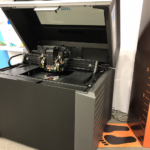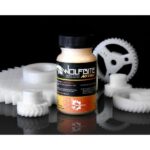

When I visit various 3D printing expos, there is usually one booth that I really enjoy stopping by and checking out. That’s the Airwolf 3D booth, where I’m always looking forward to chatting with the company’s founder, Erick Wolf, his wife Eva, and the other friendly and helpful people on hand. They always have something interesting to talk about or some new 3D printer on hand to show off. The company, because of their high-quality printers which are capable of printing in a huge range of materials, has quite the following of loyal customers.
One such customer is a man named Geoffrey Schulz. While he is almost at an age of retirement, he sometimes wonders just what he will do with all his free time once he is an official retiree. Because he is quite keen on 3D printing, more than likely he will use this time on unique and creative 3D printing projects, using his Airwolf 3D printer. Other than his fascination with 3D printing, Schulz also is an avid locomotive enthusiast, so it comes as no surprise that these two hobbies seem to be converging.
Recently Schultz got the idea of 3D printing a steam engine, but when he could not find a design for one that he really liked, he had to take things into his own hands.

“I originally did this to teach my son how steam engines work,” Schultz explains. “I found a project on Thingiverse.com for a single cylinder horizontal steam engine, but it had issues with the design. I made several changes to it and reprinted it 3 times before I got it to work.”
It took him several weeks to evaluate and print his first iterations of his engine, but his latest creation, a twin cylinder engine, took him just 4 days to design and 3D print. The design process took him just about 8 hours.
Schultz’s creation, which is designed after a steam engine, can run off of as little as just 5 psi of air pressure, and it even features a Stephenson valve for allowing the engine to run in reverse. It is entirely 3D printed out of ABS plastic, and as you can see in the video below, it runs quite well.
“The most difficult task was getting the piston and valve to fit precisely so they moved freely, yet provided a reasonable seal against air pressure,” Schultz explains. “I used FreeCad, which I found to be a very complete and well thought out open-source project. It functions very similarly to SolidWorks without the ridiculous price tag.”
So what’s next for Schulz? He now plans on 3D printing an entire working locomotive which this 3D printed engine, or one very similar, will run. In the mean time, his son, Zane also has picked up on 3D printing himself, a tool which he has used in order to design and print his own functional Rubik’s Cube. He plans to use his 3D printing skills to create his very own puzzle cubes in the future.
What do you think about this awesome 3D printed engine? Will Schulz find a way to 3D print an entire locomotive? Discuss in the 3D Printed Engine forum thread on 3DPB.com. Be sure to check out the video below, and don’t forget to check out Airwolf 3D.
If you're looking to get architectural 3D animation in the USA, our service provides an exceptional way to bring your architectural concepts to life through dynamic, immersive visuals. Through our platform, you can easily request high-quality 3D animations that showcase your designs in motion, offering a detailed view of your project from multiple angles and perspectives. Whether it's for a real estate development, a commercial building, or an urban planning project, our expert team ensures that every detail is captured in a visually compelling animation.
Through our website, you can seamlessly get architectural 3D animation tailored to your project’s specific needs. With our help, you can offer potential clients or investors an engaging experience that goes beyond static images. By integrating CGI animations with real-world settings, lighting, and textures, our team creates a lifelike experience that allows your audience to interact with your project as though it were already built. This service is perfect for presenting complex designs in a clear, visually attractive way that stands out in the competitive architectural market.




